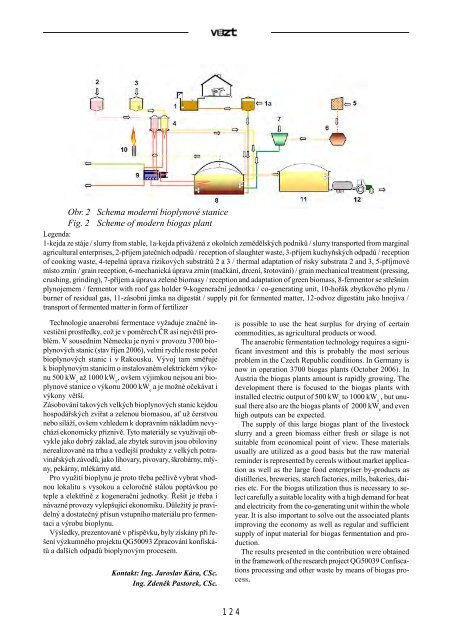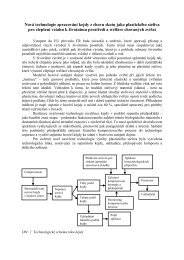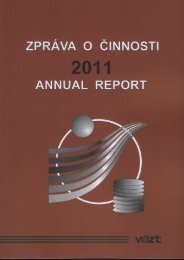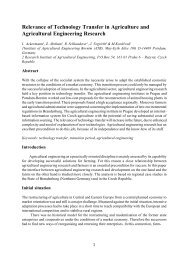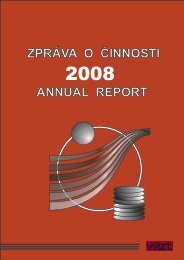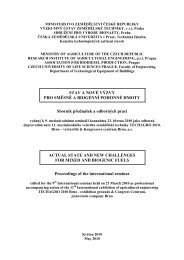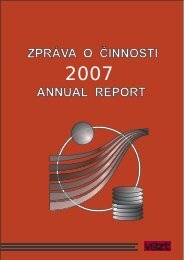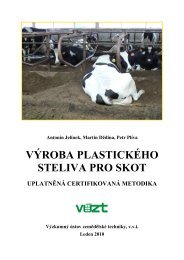Zpráva o ÄÂinnosti v roce 2006 (10MB) - SVT
Zpráva o ÄÂinnosti v roce 2006 (10MB) - SVT
Zpráva o ÄÂinnosti v roce 2006 (10MB) - SVT
Create successful ePaper yourself
Turn your PDF publications into a flip-book with our unique Google optimized e-Paper software.
Obr. 2 Schema moderní bioplynové stanice<br />
Fig. 2 Scheme of modern biogas plant<br />
Legenda:<br />
1-kejda ze stáje / slurry from stable, 1a-kejda pøivážená z okolních zemìdìlských podnikù / slurry transported from marginal<br />
agricultural enterprises, 2-pøíjem jateèních odpadù / reception of slaughter waste, 3-pøíjem kuchyòských odpadù / reception<br />
of cooking waste, 4-tepelná úprava rizikových substrátù 2 a 3 / thermal adaptation of risky substrata 2 and 3, 5-pøíjmové<br />
místo zrnin / grain reception, 6-mechanická úprava zrnin (maèkání, drcení, šrotování) / grain mechanical treatment (pressing,<br />
crushing, grinding), 7-pøíjem a úprava zelené biomasy / reception and adaptation of green biomass, 8-fermentor se støešním<br />
plynojemem / fermentor with roof gas holder 9-kogeneraèní jednotka / co-generating unit, 10-hoøák zbytkového plynu /<br />
burner of residual gas, 11-zásobní jímka na digestát / supply pit for fermented matter, 12-odvoz digestátu jako hnojiva /<br />
transport of fermented matter in form of fertilizer<br />
Technologie anaerobní fermentace vyžaduje znaèné investièní<br />
prostøedky, což je v pomìrech ÈR asi nejvìtší problém.<br />
V sousedním Nìmecku je nyní v provozu 3700 bioplynových<br />
stanic (stav øíjen <strong>2006</strong>), velmi rychle roste poèet<br />
bioplynových stanic i v Rakousku. Vývoj tam smìøuje<br />
k bioplynovým stanicím o instalovaném elektrickém výkonu<br />
500 kW e<br />
až 1000 kW e<br />
, ovšem výjimkou nejsou ani bioplynové<br />
stanice o výkonu 2000 kW e<br />
a je možné oèekávat i<br />
výkony vìtší.<br />
Zásobování takových velkých bioplynových stanic kejdou<br />
hospodáøských zvíøat a zelenou biomasou, a už èerstvou<br />
nebo siláží, ovšem vzhledem k dopravním nákladùm nevychází<br />
ekonomicky pøíznivì. Tyto materiály se využívají obvykle<br />
jako dobrý základ, ale zbytek surovin jsou obiloviny<br />
nerealizované na trhu a vedlejší produkty z velkých potravináøských<br />
závodù, jako lihovary, pivovary, škrobárny, mlýny,<br />
pekárny, mlékárny atd.<br />
Pro využití bioplynu je proto tøeba peèlivì vybrat vhodnou<br />
lokalitu s vysokou a celoroènì stálou poptávkou po<br />
teple a elektøinì z kogeneraèní jednotky. Øešit je tøeba i<br />
návazné provozy vylepšující ekonomiku. Dùležitý je pravidelný<br />
a dostateèný pøísun vstupního materiálu pro fermentaci<br />
a výrobu bioplynu.<br />
Výsledky, prezentované v pøíspìvku, byly získány pøi øešení<br />
výzkumného projektu QG50093 Zpracování konfiskátù<br />
a dalších odpadù bioplynovým p<strong>roce</strong>sem.<br />
Kontakt: Ing. Jaroslav Kára, CSc.<br />
Ing. Zdenìk Pastorek, CSc.<br />
is possible to use the heat surplus for drying of certain<br />
commodities, as agricultural products or wood.<br />
The anaerobic fermentation technology requires a significant<br />
investment and this is probably the most serious<br />
problem in the Czech Republic conditions. In Germany is<br />
now in operation 3700 biogas plants (October <strong>2006</strong>). In<br />
Austria the biogas plants amount is rapidly growing. The<br />
development there is focused to the biogas plants with<br />
installed electric output of 500 kW e<br />
to 1000 kW e<br />
, but unusual<br />
there also are the biogas plants of 2000 kW e<br />
and even<br />
high outputs can be expected.<br />
The supply of this large biogas plant of the livestock<br />
slurry and a green biomass either fresh or silage is not<br />
suitable from economical point of view. These materials<br />
usually are utilized as a good basis but the raw material<br />
reminder is represented by cereals without market application<br />
as well as the large food enterpriser by-products as<br />
distilleries, breweries, starch factories, mills, bakeries, dairies<br />
etc. For the biogas utilization thus is necessary to select<br />
carefully a suitable locality with a high demand for heat<br />
and electricity from the co-generating unit within the whole<br />
year. It is also important to solve out the associated plants<br />
improving the economy as well as regular and sufficient<br />
supply of input material for biogas fermentation and production.<br />
The results presented in the contribution were obtained<br />
in the framework of the research project QG50039 Confiscations<br />
p<strong>roce</strong>ssing and other waste by means of biogas p<strong>roce</strong>ss.<br />
124


